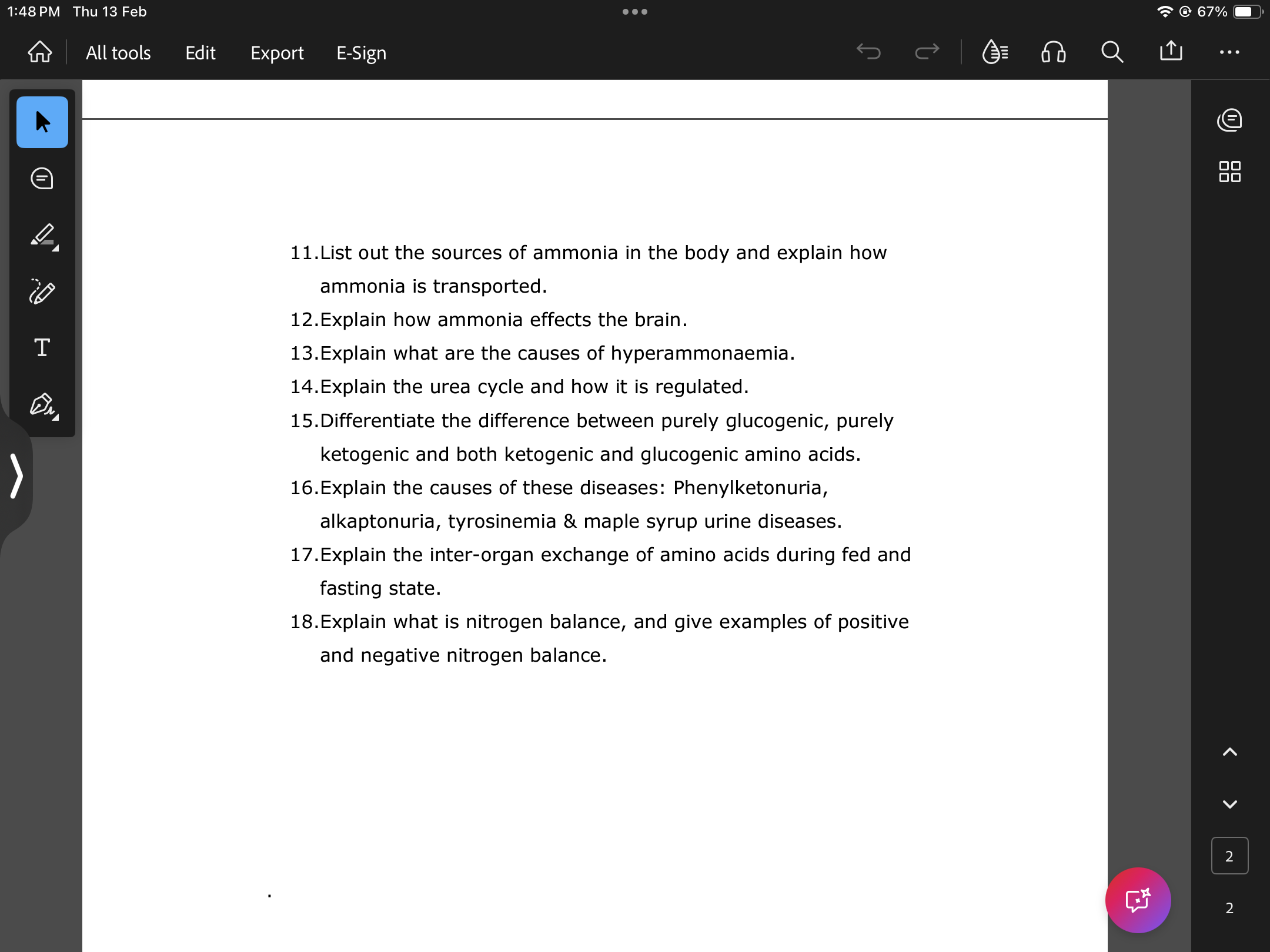List out the sources of ammonia in the body and explain how ammonia is transported. Explain how ammonia effects the brain. Explain what are the causes of hyperammonaemia. Explain t... List out the sources of ammonia in the body and explain how ammonia is transported. Explain how ammonia effects the brain. Explain what are the causes of hyperammonaemia. Explain the urea cycle and how it is regulated. Differentiate the difference between purely glucogenic, purely ketogenic and both ketogenic and glucogenic amino acids. Explain the causes of these diseases: Phenylketonuria, alkaptonuria, tyrosinemia & maple syrup urine diseases. Explain the inter-organ exchange of amino acids during fed and fasting state. Explain what is nitrogen balance, and give examples of positive and negative nitrogen balance.

Understand the Problem
The image contains a list of questions related to the metabolism of ammonia, urea cycle, amino acids, and nitrogen balance in the body. These questions are likely for a biochemistry or related course.
Answer
The answers cover ammonia sources, transport, brain effects, hyperammonemia causes, urea cycle, amino acid classifications, causes of metabolic diseases, inter-organ amino acid exchange, and nitrogen balance.
Here are concise answers to your questions:
-
Sources of ammonia: -Metabolism of amino acids and other nitrogen-containing compounds. -Bacterial metabolism in the intestines. Ammonia transport: -As ammonium ion (NH4+) in the blood. -As glutamine, which is synthesized in tissues and transported to the liver and kidneys.
-
Effects of ammonia on the brain: -Increased ammonia leads to increased glutamine production in the brain. -Accumulation of glutamine leads to transfer of tryptophan into the brain.
-
Causes of hyperammonemia: -Liver disease. -Kidney failure. -Genetic disorders of the urea cycle.
-
Urea cycle: -A series of biochemical reactions that convert ammonia into urea for excretion. -Regulation: Substrate availability, enzyme induction, and allosteric activation of carbamoyl phosphate synthetase I by N-acetylglutamate.
-
Amino acid classification: -Glucogenic: Amino acids that can be converted into glucose. -Ketogenic: Amino acids that can be converted into ketone bodies. -Both: Amino acids that can be converted into both glucose and ketone bodies.
-
Causes of diseases: -Phenylketonuria: Deficiency in phenylalanine hydroxylase. -Alkaptonuria: Deficiency in homogentisate oxidase. -Tyrosinemia: Deficiency in fumarylacetoacetate hydrolase. -Maple Syrup Urine Disease: Deficiency in branched-chain alpha-keto acid dehydrogenase complex.
-
Inter-organ exchange of amino acids: -Fed state: Amino acids are primarily taken up by the liver and muscle for protein synthesis. -Fasting state: Muscle protein is broken down, releasing amino acids into the bloodstream for use by other tissues, such as the liver for gluconeogenesis.
-
Nitrogen balance: -The difference between nitrogen intake and nitrogen excretion. -Positive nitrogen balance: Intake exceeds excretion (e.g., growth, pregnancy). -Negative nitrogen balance: Excretion exceeds intake (e.g., starvation, illness).
Answer for screen readers
Here are concise answers to your questions:
-
Sources of ammonia: -Metabolism of amino acids and other nitrogen-containing compounds. -Bacterial metabolism in the intestines. Ammonia transport: -As ammonium ion (NH4+) in the blood. -As glutamine, which is synthesized in tissues and transported to the liver and kidneys.
-
Effects of ammonia on the brain: -Increased ammonia leads to increased glutamine production in the brain. -Accumulation of glutamine leads to transfer of tryptophan into the brain.
-
Causes of hyperammonemia: -Liver disease. -Kidney failure. -Genetic disorders of the urea cycle.
-
Urea cycle: -A series of biochemical reactions that convert ammonia into urea for excretion. -Regulation: Substrate availability, enzyme induction, and allosteric activation of carbamoyl phosphate synthetase I by N-acetylglutamate.
-
Amino acid classification: -Glucogenic: Amino acids that can be converted into glucose. -Ketogenic: Amino acids that can be converted into ketone bodies. -Both: Amino acids that can be converted into both glucose and ketone bodies.
-
Causes of diseases: -Phenylketonuria: Deficiency in phenylalanine hydroxylase. -Alkaptonuria: Deficiency in homogentisate oxidase. -Tyrosinemia: Deficiency in fumarylacetoacetate hydrolase. -Maple Syrup Urine Disease: Deficiency in branched-chain alpha-keto acid dehydrogenase complex.
-
Inter-organ exchange of amino acids: -Fed state: Amino acids are primarily taken up by the liver and muscle for protein synthesis. -Fasting state: Muscle protein is broken down, releasing amino acids into the bloodstream for use by other tissues, such as the liver for gluconeogenesis.
-
Nitrogen balance: -The difference between nitrogen intake and nitrogen excretion. -Positive nitrogen balance: Intake exceeds excretion (e.g., growth, pregnancy). -Negative nitrogen balance: Excretion exceeds intake (e.g., starvation, illness).
More Information
The urea cycle is a critical metabolic pathway for removing toxic ammonia from the body. Genetic defects in urea cycle enzymes can cause hyperammonemia.
Tips
When discussing metabolic disorders, remember to specify the deficient enzyme and the accumulated substrate.
Sources
- Ammonia Levels: Causes, Symptoms & Treatment - Cleveland Clinic - my.clevelandclinic.org
- Hyperammonemia - StatPearls - NCBI Bookshelf - ncbi.nlm.nih.gov
- Hyperammonemia: What It Is, Causes, Symptoms & Treatment - my.clevelandclinic.org
- Biochemistry, Ammonia - StatPearls - NCBI Bookshelf - ncbi.nlm.nih.gov
- Chapter-10 Amino Acid Metabolism - JaypeeDigital - jaypeedigital.com
AI-generated content may contain errors. Please verify critical information